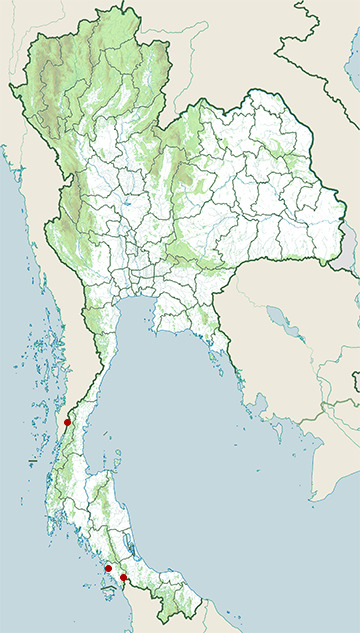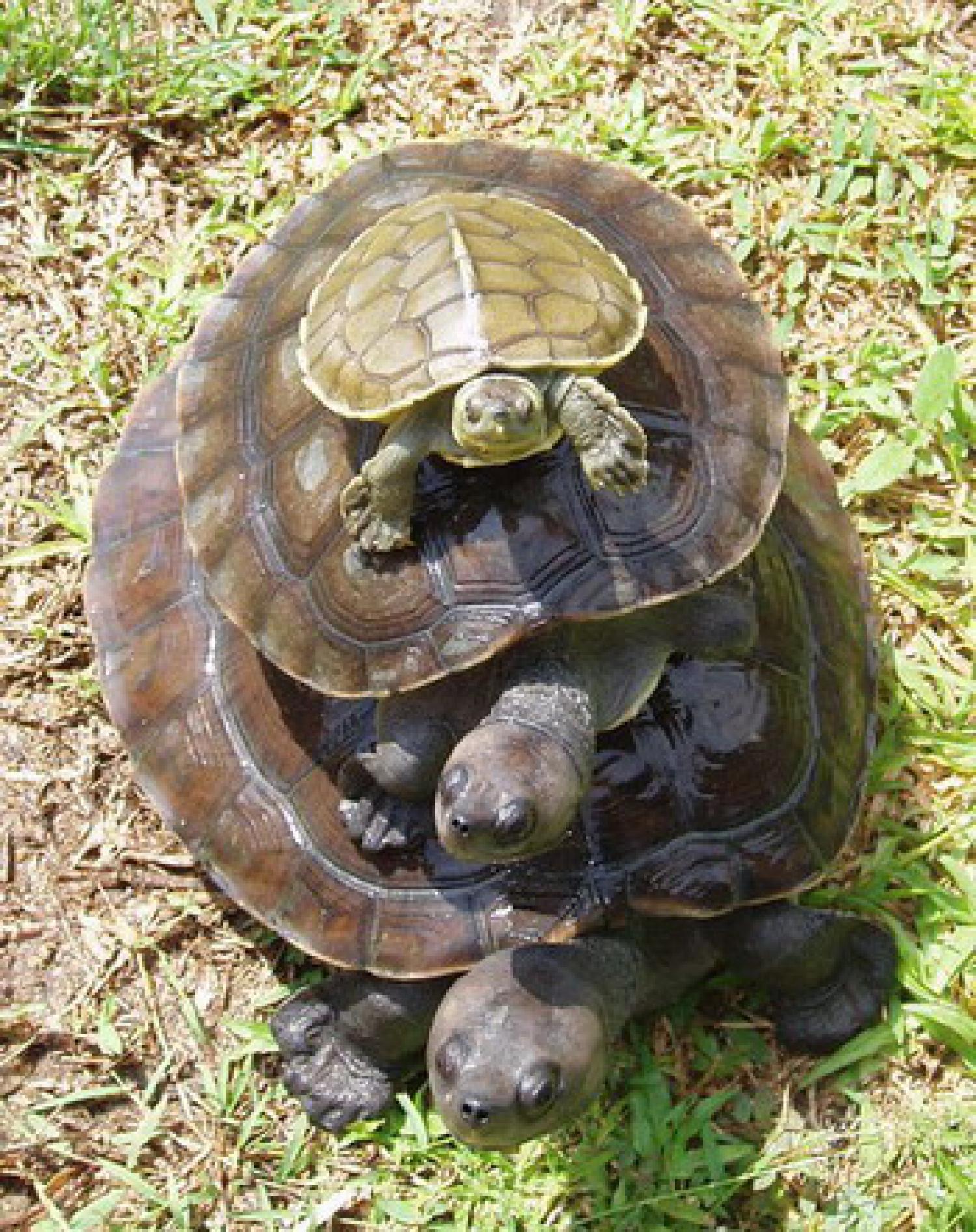Species of Thailand
Northern river terrapin
Batagur baska
John Edward Gray, 1830
In Thai: เต่าจาน, dtao jaan
The northern river terrapin (Batagur baska), is a species of riverine turtle. It is one of the most critically endangered turtle species according to a 2000 assessment by the IUCN.
Description/Identification
Physical Structure: One of Asia's largest freshwater and brackish turtles. Carapace moderately depressed, with a vertebral keel in the young, which keel disappears in the adult; nuchal broader than long; first vertebral as broad in front as behind, or a little broader; vertebrals 2 to 4 subequal, much broader than long in the young, nearly as long as broad and as broad as the costals in the adult, the postero-lateral border of the third vertebral strongly concave. Plastron large, strongly angulate laterally in the young, convex in the adult, truncate anteriorly, angularly notched posteriorly; the width of the bridge exceeds the length of the posterior lobe; the longest median suture is that between the abdominals, the shortest that between the gulars, the latter never more than half that between the humerals; inguinal large, axillary smaller. Head rather small; snout pointed, produced, directed upwards; jaws with denticulated edge, upper feebly notched mesially; the width of the lower jaw at the symphysis nearly equals the diameter of the orbit. Limbs with transversely enlarged, band-like scales.
Color Pattern: Normally upper surface of shell (carapace) and soft parts olive-brown, lower surface (plastron) yellowish. Males in breeding coloration as having the head and ventral part of the neck black, with the coloration of the dorsal portion of the neck to its base rich crimson or bright red-orange and the whole of the forelimbs as brilliant rosy carmine or rusty to light orange. Hind parts dull reddish purple. During the breeding season, the color of the pupils of a female brown whereas the pupils in the males become yellowish-white. Their neck and head have a dark brown pigmentation and the base of the neck and forelimbs have a reddish pigmentation. This reddish pigmentation makes the Sunderban’s river terrapins a unique species.
Length (carapace): Maximum:60 cm.and Common:40 cm.
Maximum published weight: 18 kg.
Sub-species
Two subspecies was established:
B b baska Gray, 1831
B b ranongensis Nutaphand, 1979
Common names
Bengali: মুখপোড়া কাইট্টা (Mukhpoda kaitta), কেটো কচ্ছপ, বোদো কাইট্টা, বাটাগুর কাইট্টা, কালো-মাথা কাইট্টা, মুখপোড়া কাছিম।
Burmese:
English: Asian river terrapin Batagur, Common batagur, Four-toed terrapin, Giant river terrapin, Giant river turtle, Mangrove terrapin, Northern river terrapin, and River terrapin.
Distribution
Found only in Bangladesh (The Sundarbans and in captivity in Vawal National Park at Gazipur), Cambodia, India (parts- West Bengal & Orissya), Indonesia & Malaysia and Regionally extinct in Myanmar, Singapore, Thailand & Vietnam.
Habitat
Terrestrial & highly aquatic (freshwater & brackish); lives in tidal areas of the estuaries of medium and large rivers and also in mangrove habitat.
Habit
Amphibian. Little known about the natural ecology and behavior of Batagurs, partly because the highly silted rivers of their habitat make observations particularly difficult. Mainly prefers freshwater habitats and go up to brackish river mouths or estuaries in the breeding season. After laying eggs they return to the freshwater. Individuals known to undertake massive seasonal migrations of 50 to 60 miles to the sand banks that constitutes their breeding grounds.
Diet
Omnivorous. Takes waterside plants and small animals such as clams.
Reproduction
Oviparous; usually lays three clutches of between 10 and 34 eggs each during the breeding season in December–March; when she has laid her clutch of eggs she covers the nest with sand and then rises and falls on the surface to compact the sand.
Uses
Used as precious tasty meat-food and also its eggs considered as a delicacy. Over the last century, and until recently, the commercial trade of turtles in Calcutta has been staggering. Immense numbers were shipped into the fish markets of Calcutta from throughout India. Among the Bengali Hindus, the river terrapin was considered the most delectable of all turtles.
Play rolls on echo-system by eating plants & small animals and otherwise.
Threat to humans
May pack a painful bite and cause injure if handled, but not aggressive or toxic or harmful otherwise.
IUCN threat status
Critically Endangered (CR).
Conservation status & Cautionary measures
A hatchery and captive breeding project was established in Vawal National Park at Gazipur in Bangladesh and another in Sajnekhali Forest Station in the Sunderban Tiger Reserve in India. There many individuals hatched and hopefilly population increases day by day and the species returned from the eve of the extinction point.
This article uses material from Wikipedia released under the Creative Commons Attribution-Share-Alike Licence 3.0. Eventual photos shown in this page may or may not be from Wikipedia, please see the license details for photos in photo by-lines.
Scientific classification
- Kingdom
- Animalia
- Phylum
- Chordata
- Class
- Reptilia
- Order
- Testudines
- Family
- Geoemydidae
- Genus
- Batagur
- Species
- Batagur baska
Common names
- German: Batagur-Flussschildkröte
- English:
- The northern river terrapin
- River terrapin
- Batagur
- Thai:
- เต่าจาน, dtao jaan
- เต่ากระอาน, dtao kra-aan
Subspecies
Batagur baska baska, John Edward Gray, 1831
Batagur baska ranongensis, Wirot Nutaphand, 1979
Conservation status

Critically Endangered (IUCN2.3)
Photos
Please help us review our species pages if wrong photos are used or any other details in the page is wrong. We can be reached via our contact us page.
Range Map

- Kra Buri River
- La-ngu District, Satun
- Thale Ban National Park
